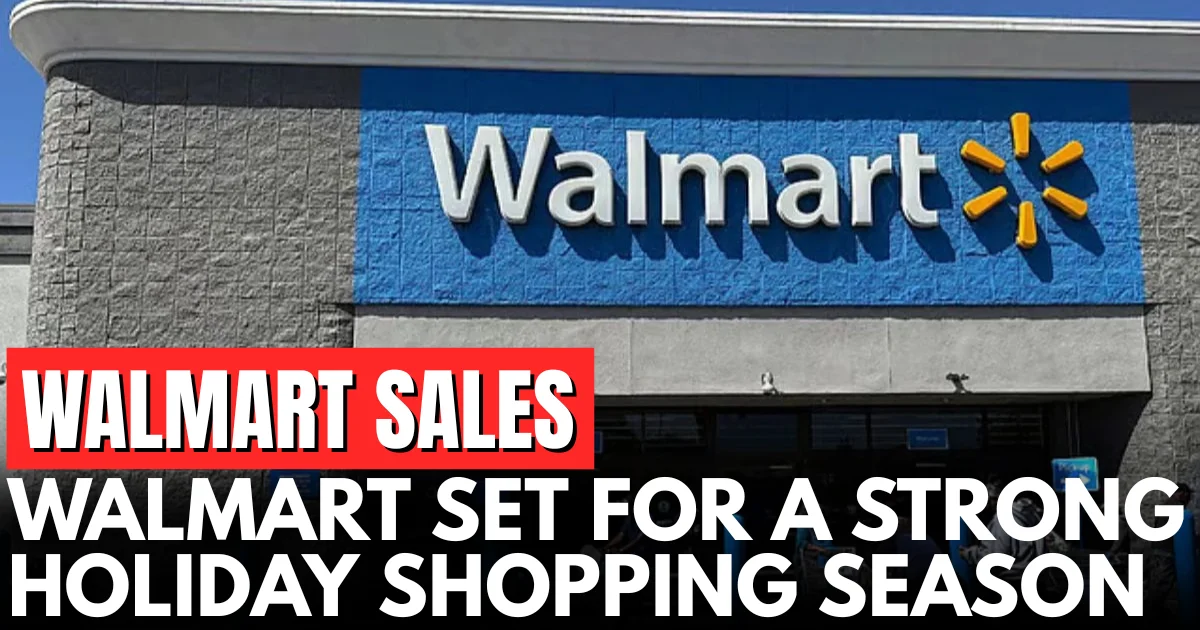Walmart anticipates robust holiday sales as budget-conscious shoppers hunt for deals. Retail strategy, consumer trends, and economic outlook analyzed.
Table of Contents
Walmart Anticipates Strong Holiday Sales as Budget-Conscious Shoppers Hunt for Value and Deals
Retail giant Walmart projects robust holiday season sales as the company positions itself to capture deal-seeking consumers navigating economic uncertainty and inflation concerns. The optimistic forecast reflects strategic pricing initiatives, expanded inventory, and enhanced shopping experiences designed to attract budget-conscious families.
The retailer’s confidence comes as American consumers demonstrate continued willingness to spend during the critical holiday season while simultaneously showing heightened price sensitivity. For investors, competing retailers, and economic analysts, Walmart’s outlook provides important signals about consumer health and retail sector performance.
Walmart’s Holiday Strategy
The retail giant implemented comprehensive approaches designed to maximize holiday season market share and revenue.
Pricing and promotions:
Aggressive discounting across key categories aims to position Walmart as the value leader during competitive holiday shopping periods. Electronics, toys, home goods, and apparel receive particular promotional emphasis.
Early holiday deals starting before traditional Black Friday create extended shopping windows. This strategy spreads consumer spending across longer periods reducing single-day logistics pressures while capturing early shoppers.
Price matching guarantees and rollback pricing on thousands of items reinforce Walmart’s value positioning. The company leverages massive purchasing power to offer competitive prices that smaller retailers struggle to match.
Inventory positioning:
Walmart stocked shelves with anticipation of strong demand across popular categories. Toy selection expanded significantly recognizing that gift-giving drives holiday sales.
Supply chain improvements ensure product availability preventing the stockout issues that plagued retailers in recent years. Inventory management balances adequate selection with avoiding excess that requires post-holiday clearance.
Strategic product mix emphasizes value-priced items alongside premium offerings. This tiered approach serves diverse consumer budgets from tight to comfortable.
Consumer Behavior Driving Expectations
Walmart’s optimism reflects observed shopping patterns and economic indicators suggesting sustained consumer spending despite headwinds.
Deal-seeking intensity:
Shoppers demonstrate heightened price sensitivity comparing options across retailers before purchasing. Mobile apps and price comparison websites enable instant competitive analysis.
Coupon usage and promotional shopping increased as consumers maximize purchasing power. Digital coupons and app-based deals particularly appeal to tech-savvy shoppers.
Trade-down behavior shows consumers selecting value brands over premium alternatives. Private label products gain market share as quality improves while maintaining price advantages.
Shopping timeline shifts:
Holiday shopping extends across longer periods rather than concentrating in post-Thanksgiving weeks. Early November purchases through late December spread spending reducing pressure on any single shopping weekend.
Cyber Monday gains importance as online shopping convenience appeals to time-constrained consumers. E-commerce represents growing holiday sales proportion.
Economic context:
Despite inflation concerns, employment remains relatively strong supporting consumer spending ability. Wage growth provides income supporting discretionary purchases.
Credit card usage increases during holidays as consumers leverage financing for larger purchases. Buy-now-pay-later options gain popularity particularly among younger shoppers.
Savings rates vary with some consumers maintaining healthy buffers while others operate closer to financial edges. This bifurcation creates diverse shopping behaviors.
Retail Competition Landscape
Walmart’s holiday performance expectations occur within intensely competitive retail environment.
Primary competitors:
Target pursues similar value-conscious consumers while emphasizing style and curated selections. The Minneapolis-based retailer differentiates through design partnerships and merchandising.
Amazon dominates e-commerce with unmatched selection and logistics. The online giant’s subscription services and fast shipping create loyalty challenges for traditional retailers.
Dollar stores including Dollar General and Dollar Tree capture extreme budget shoppers. These competitors thrive during economic uncertainty when consumers trade down.
Department stores and specialty retailers compete for specific categories. Macy’s, Kohl’s, and others emphasize experience and brand selections.
Competitive advantages:
Walmart’s scale enables cost advantages through purchasing power and operational efficiency. Size creates barriers protecting market position.
Omnichannel capabilities blending online ordering with physical store pickup provide convenience. Customers appreciate options combining digital browsing with immediate product availability.
Grocery integration drives frequent store visits creating opportunities for non-food purchases. Food shopping traffic benefits general merchandise sales.
E-Commerce and Digital Integration
Online shopping represents critical component of Walmart’s holiday strategy.
Digital capabilities:
Website and mobile app improvements enhance user experience. Intuitive navigation, detailed product information, and customer reviews facilitate purchasing decisions.
Same-day delivery and curbside pickup options compete with Amazon’s convenience. Leveraging physical store network for fulfillment provides speed advantages.
Digital marketing through social media, search advertising, and email campaigns targets consumers where they spend time. Personalized recommendations based on browsing and purchase history increase conversion rates.
Online versus in-store dynamics:
Certain categories including electronics and toys see higher online purchase rates. Consumers research extensively online even when purchasing in stores.
Grocery and immediate-need items maintain stronger in-store shopping patterns. Perishables and last-minute purchases favor physical retail.
Cross-channel behavior shows consumers browsing online before buying in stores or vice versa. Seamless experiences across channels capture these shoppers.
Economic Indicators and Consumer Confidence
Walmart’s optimistic forecast assumes continued consumer spending despite economic uncertainties.
Supporting factors:
Labor market strength with low unemployment supports income and spending. Job security enables discretionary purchases during holidays.
Wage growth helps offset inflation impacts. While price increases concern consumers, income gains provide purchasing power.
Household balance sheets remain relatively healthy for many Americans. Pandemic-era savings cushions and debt reduction support spending capacity.
Concerning signals:
Credit card debt levels increasing suggest some consumers stretching financially. Higher balances and delinquency rates warrant monitoring.
Inflation persistence affects real purchasing power. Even with wage growth, price increases reduce what money buys.
Consumer confidence surveys show mixed sentiment. Optimism about personal finances contrasts with pessimism about broader economy.
Impact on Walmart Stock and Financial Performance
Holiday season performance significantly affects Walmart’s annual financial results and stock valuation.
Revenue concentration:
Fourth quarter typically represents highest sales period driven by holiday shopping. November and December generate disproportionate annual revenue.
Comparable store sales growth during holidays influences full-year performance. Strong holiday numbers can offset softer periods throughout the year.
Investor implications:
Stock performance often correlates with holiday sales expectations and results. Positive guidance boosts investor confidence while disappointments trigger sell-offs.
Earnings reports following the holiday season provide definitive performance data. Actual results compared to guidance affect market reactions.
Retail sector investment depends partly on consumer spending health. Walmart results provide bellwether indicators about broader retail conditions.
Supplier and Manufacturing Relationships
Holiday sales projections affect entire retail supply chain beyond just Walmart.
Supplier impacts:
Manufacturers produce based on retailer forecasts. Optimistic Walmart projections drive production planning across suppliers.
Order volumes and timing affect supplier financial performance. Large holiday orders represent significant revenue concentration for many manufacturers.
Inventory risk sharing between retailers and suppliers affects relationships. Negotiations about return policies and markdown support influence partnership dynamics.
Import and logistics:
International sourcing requires months of advance planning. Ocean freight, customs processing, and domestic distribution demand coordination.
Port congestion and shipping costs affect profitability. Supply chain efficiency directly impacts margins on imported goods.
Broader Retail Industry Implications
Walmart’s performance and strategy influence competitive dynamics and industry trends.
Market share battles:
Strong Walmart holiday sales could come at competitors’ expense. Zero-sum dynamics in certain categories mean one retailer’s gain equals another’s loss.
Pricing aggression forces competitive responses. Matching or exceeding Walmart discounts pressures margins across the industry.
Industry health indicators:
Collective retail performance during holidays signals consumer spending strength. Robust sales across retailers suggest healthy economy while weakness raises concerns.
Inventory levels post-holiday indicate demand accuracy. Excess inventory requiring deep discounting suggests overestimation while stockouts indicate missed opportunities.
What This Means for Shoppers
Consumers benefit from competitive retail environment and strategic holiday planning.
Shopping strategies:
Comparing prices across retailers maximizes value. Walmart’s aggressive pricing doesn’t guarantee lowest prices on every item.
Timing purchases strategically captures best deals. Some items discount deeper as holidays approach while others sell out.
Combining sales, coupons, and credit card rewards stacks savings. Sophisticated shoppers layer multiple discounts.
Deal expectations:
Heavy discounts on electronics, toys, and seasonal items follow historical patterns. These categories see aggressive promotional activity.
Grocery and essentials maintain steadier pricing. Holiday meal ingredients may see tactical promotions but less dramatic discounting.
FAQ SECTION
1. Why is Walmart optimistic about holiday sales despite economic concerns?
Walmart’s confidence stems from observed consumer behavior showing continued willingness to spend while seeking value, strong employment supporting income and purchasing power, strategic pricing initiatives positioning the retailer as value leader, expanded inventory across popular categories, and enhanced omnichannel capabilities blending online convenience with physical store benefits. The company believes budget-conscious shoppers will prioritize value retailers during the holiday season even amid inflation concerns and economic uncertainty.
2. How does Walmart compete with Amazon during the holidays?
Walmart leverages its massive physical store network for same-day delivery and curbside pickup providing speed advantages, offers competitive pricing through enormous purchasing power, integrates grocery shopping that drives frequent store visits creating non-food purchase opportunities, and enhances digital capabilities through improved website and mobile app experiences. The omnichannel approach combining online convenience with immediate product availability through local stores differentiates Walmart from Amazon’s purely digital model.
3. When is the best time to shop for holiday deals at Walmart?
Walmart extends holiday promotions across longer periods starting early November through late December, reducing concentration around traditional Black Friday. Electronics and toys may see deepest discounts during Black Friday weekend and Cyber Monday, though early deals throughout November offer competitive pricing. Some items discount deeper as holidays approach while popular products risk selling out. Shoppers benefit from monitoring prices across the season, comparing online and in-store offers, and acting quickly on compelling deals.
4. What categories will see the biggest discounts?
Electronics including televisions, computers, and gaming systems typically receive aggressive promotional pricing. Toys see substantial discounts as Walmart competes for gift-giving budgets. Home goods, small appliances, and seasonal items feature heavy promotions. Apparel and accessories offer competitive deals particularly on value brands. Grocery and essentials maintain steadier pricing though tactical promotions appear on holiday meal ingredients. Premium and newest products generally see smaller percentage discounts than value items and prior-year models.
5. How do Walmart’s holiday sales affect the overall economy?
As America’s largest retailer, Walmart’s performance provides bellwether indicators about consumer spending health and economic conditions. Strong holiday sales signal consumer confidence and spending capacity supporting economic growth. The company’s performance affects suppliers, manufacturers, logistics providers, and entire retail supply chain. Employment at Walmart and partners increases during holidays. Investor reactions to results influence stock markets. Walmart’s strategies regarding pricing, inventory, and promotions set competitive dynamics affecting the entire retail industry.
CONCLUSION
Walmart’s optimistic holiday sales outlook reflects strategic positioning to capture budget-conscious consumers seeking value during the critical shopping season. The retail giant’s confidence stems from observed consumer behavior, competitive pricing strategies, enhanced omnichannel capabilities, and economic indicators supporting continued spending despite headwinds.
For American consumers, competitive retail dynamics create opportunities to maximize purchasing power through strategic shopping, price comparison, and taking advantage of extended promotional periods. Whether shopping online or in-store, deal-seeking behaviors align with retailers’ efforts to attract business.
The holiday season’s performance will provide crucial insights into consumer financial health, spending priorities, and economic trajectory. Walmart’s results, alongside competitor performance, will influence retail industry outlook and investor sentiment extending into the new year.
As shoppers prepare for holiday purchasing, understanding retailer strategies, timing promotions, and comparing options enables informed decisions maximizing value. Walmart’s aggressive holiday positioning ensures competitive pricing across key categories benefiting consumers navigating inflationary pressures while maintaining gift-giving traditions.
How are you planning your holiday shopping this year? What strategies do you use to find the best deals? Share your shopping tips in the comments!

